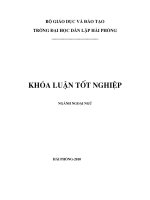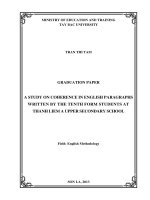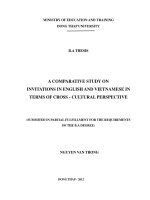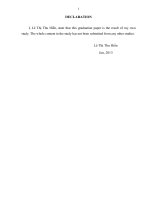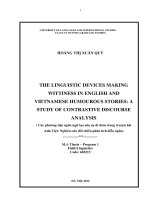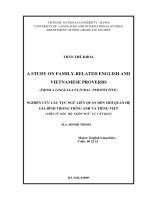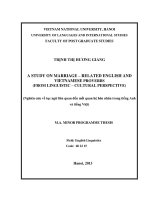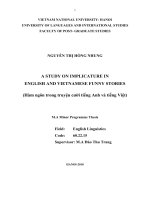a study on implicature in english and vietnamese funny stories = hàm ngôn trong truyện cười tiếng anh và tiếng việt
Bạn đang xem bản rút gọn của tài liệu. Xem và tải ngay bản đầy đủ của tài liệu tại đây (1.15 MB, 56 trang )
1
VIETNAM NATIONAL UNIVERSITY- HANOI
UNIVERSITY OF LANGUAGES AND INTERNATIONAL STUDIES
FACULTY OF POST- GRADUATE STUDIES
NGUYỄN THỊ HỒNG NHUNG
A STUDY ON IMPLICATURE IN
ENGLISH AND VIETNAMESE FUNNY STORIES
(Hàm ngôn trong truyện cười tiếng Anh và tiếng Việt)
M.A Minor Programme Thesis
Field: English Linguistics
Code: 60.22.15
Supervisor: M.A Đào Thu Trang
HANOI-2010
2
VIETNAM NATIONAL UNIVERSITY- HANOI
UNIVERSITY OF LANGUAGES AND INTERNATIONAL STUDIES
FACULTY OF POST- GRADUATE STUDIES
NGUYỄN THỊ HỒNG NHUNG
A STUDY ON IMPLICATURE IN
ENGLISH AND VIETNAMESE FUNNY STORIES
(Hàm ngôn trong truyện cười tiếng Anh và tiếng Việt)
M.A Minor Programme Thesis
Field: English Linguistics
Code: 60.22.15
Supervisor: M.A Đào Thu Trang
HANOI-2010
6
TABLE OF CONTENTS
STATEMENT OF AUTHORSHIP………
i
ACKNOWLEDGEMENTS…………………………………………………………
ii
ABSTRACT…………………………………………………………………………
iii
LIST OF TABLE AND FIGURE…………………………………………………
vi
PART A: INTRODUCTION………………………………………………………
1
1. Rationale………………………………………………………………………….
1
2. Aims of the Study………………………………………………………………
2
3. Scope of the Study
2
4. Method of the Study
2
5. Organization of the Study
2
PART B: DEVELOPMENT
4
CHAPTER 1: THEORETICAL BACKGROUND
4
1.1. Overview of Discourse Analysis
4
1.1.1. Definition of Discourse
4
1.1.2. Discourse versus Text
4
1.1.3. Discourse Analysis
5
1.1.4. Context in Discourse Analysis
6
1.2. Word Meaning
6
1.3. Sentence Meaning
7
1.4. Utterance Meaning
8
1.5. Implicature
12
1.5.1. The Notion of Implicature
12
1.5.2. The Cooperative Principal and Maxims
13
1.5.2.1. The Maxim of Quantity
13
1.5.2.2. The Maxim of Quality
14
1.5.2.3. The Maxim of Relation
15
1.5.2.4. The Maxim of Manner
16
7
1.5.3. Non- Observance
16
1.6. Overview of Funny Stories
17
CHAPTER 2: THE STUDY
19
2.1. Research question
19
2.2. Data collection
19
2.3. Data Analysis
19
2.3.1. Maxim of Quantity
19
2.3.2. Maxim of Quality
24
2.3.3. Maxim of Relation
27
2.3.4. Maxim of Manner
30
2.4. Discussion
34
2.4.1. Result and Discussion of the Result………………………………………
34
2.4.2. Similarities
35
2.4.3. Differences
35
PART C: CONCLUSION
37
1. Major Findings
37
2. Implications to Language Teaching and Learning
37
3. Limitation of the Study and Suggestions for Further Study
40
REFERENCES
42
APPENDICES……………………………………………………………………
I
APPENDIX 1: ENGLISH FUNNY STORIES
I
APPENDIX 2: VIETNAMESE FUNNY STORIES
V
8
LIST OF TABLE AND FIGURE
Table 1: Breaking maxims in English and Vietnamese funny stories……………………34
Figure 1: Breaking maxims in English and Vietnamese funny stories……
9
PART A: INTRODUCTION
1. Rationale
Language is one of the most important areas of human development. It is the
mechanism by which people communicate, and the means by which people convey their
emotion. However, in our day-to-day conversational exchanges, for some reasons, people do
not always directly express their ideas. As Jenny Thomas states in her book “Meaning in
Interaction” that speaker frequently means much more than their words actually say (Thomas
1995: 1). The hearer interprets a meaning that is not clearly stated in the utterance of the
speaker. Utterances, standing alone out of context, make us confused in our communication.
However, being put into the context, words and phrases can be interpreted in a way that
makes people understand the intentional meaning of the utterances. The reason is that we as
speakers and hearers, according to the American philosopher- linguistics Paul Grice, operate
under the cooperative principal, which means that both speaker and hearer converse with
good intentions. In other words, the speaker utters words and phrases in order to deliver a
message to the hearer, who interprets a meaning with the knowledge that there is a message
behind the utterance.
In order to show what goes on in conversation, Grice introduced four conversational
maxims. A speaker might fall to observe a maxim but still get the intended meaning through
to the hearer. Falling to observe a maxim is often referred to as “breaking a maxim”. In
funny story, these maxims are constantly broken to create humor.
Funny stories are a crucial part of every culture and every society. From the past to
now, it has been an entertaining form to make people feel cheerful and happy. Sometimes, it
can be used as a means of weapon to fight against the negative things in the society.
However, different types of humor are more appealing to different people based on their
personal sense of humor and background. And people from different countries have their
own sense of humor, therefore understanding funny stories means that you have to uncover
many things relating to their nations. Sometimes we wonder why some unfinished and
meaningless sentences can make people laugh. To achieve this interpretation successfully,
readers have to understand intended meaning from the characters and the authors.
Being a teacher of English as a foreign language, I strongly believe that the use of
humor in funny story would significantly improve second language learning. However, to
understand the meaning of implicature in English funny story is a challenging task. In order
to create more interests in the English learning and build a deep understanding of inplicature
10
mechanism to English learners, the study on “Implicature in English and Vietnamese
funny stories” is inspired and carried out. .
2. Aims of the study
The purposes of the research study could be clearly identified as followings:
- To provide background knowledge of implicature
- To uncover the implicature in terms of maxim conveyed in the English and Vietnamese
funny stories under study
- To point out implicature in some English and Vietnamese funny stories in terms of
maxims.
- To draw out the implication in English language teaching and learning.
3. Scope of the study
This research is limited to analyze implicature in some selected English and Vietnamese
funny stories.
This research only touches a small aspect of implicature: maxim
Within the scope of the study, no attention is paid to any other features of funny stories.
4. Method of the study
The main method of the study is qualitative one executed with descriptive and contrastive
analysis with the following techniques:
+ Collecting data containing funny stories with mechanism of implicature
+ Basing on the data collected, we sort out the samples into categories in terms of maxims.
+ On the basis of the analysis of mechanism of implicatures in English and Vietnamese
funny stories, we predict the difficulties that Vietnamese learners have to deal with.
5. Organization of the study
The study consists of three parts. They are:
Part A: Introduction. This part contains rationale, aims of the study, scope of the study,
and methods of the study.
Part B: Development. This is the main part of the thesis and has two chapters.
Chapter 1: Literature review
11
In this chapter, review on some field of semantics, pragmatics and discourse such are given
in the first place. Later part deals with concept of implicature and a brief background
knowledge about funny stories.
Chapter 2: The study
This part gives the detailed description of the study, which includes data collection, data
analysis and presents the results and discussion
Part C: Conclusion
This is the last part of the thesis which summarizes the major points and gives the
implication as well as giving suggestions for further study.
12
PART B: DEVELOPMENT
CHAPTER 1: THEORETICAL BACKGROUND
1.1. Overview of discourse analysis
1.1.1. Definition of discourse
In the history of linguistics, different linguists use the term “discourse” in a number
of different ways.
According to Crystal (1992: 25) discourse is “a continuous stretch of (especially
spoken) language larger than a sentence, often constituting a coherent unit, such as a sermon,
an argument, joke or narrative”
Cook (1989: 156) shares the similar idea with Crystal, he states discourse as
“stretches of language perceived to be meaningful, unified and purposive”. Cook also
suggests that “What matters is not its conformity to rules, but the fact that it communicates
and is recognized by its receivers as coherent”. Discourse is supposed to be meaningful and
thus to be used to communicate with one person in a way that another person does not have
the necessary knowledge to make sense of.
In Nunan‟s opinion, discourse is considered “communicative event involving
language in context” (1993:118)
In general, discourse is defined differently but they have something in common.
Discourse is understood as language in use, which can reflect people‟s point of view and
value systems.
1.1.2. Discourse versus text
There has been a lot of confusion between the two terms discourse and text. For some
linguists, these two terms seem to be used almost interchangeably. As Halliday & Hasan
(1976: 2) state in their book “Cohesion in English”.
A text is a unit of language in use, it is not a grammatical unit, like a clause or a
sentence… A text is best regarded as a semantic unit: a unit not of form but of
meaning. Thus it is related to a clause or sentence not by size but by realization, the
coding of one symbolic system in another. A text does not consist of sentences; it is
realized by, or encoded in, sentences.
They use “text” to refer to “discourse”. They see text as a “semantic unit” characterized by
cohesion.
13
Some other linguists draw a clear distinction between them. They argue that
discourse is language in action while a text is the written record of that interaction.
As Crystal‟s point of view, he states that discourse is “a continuous stretch of
language larger than a sentence” whereas a text is “a piece of naturally occurring spoken,
written or signed language identified for purpose of analysis”.
Nunan (1993: 6) appears to share the same view when he uses “the term text to refer
to any written record of a communicative event in context” and discourse refers to
“interpretation of the communicative event in context”
To sum up, it can be see that there is disagreement about the meaning of these two
terms. However, all seem to agree that both text and discourse need to be defined in terms of
meaning and the coherent texts/ pieces of discourse are those that form a meaningful whole.
1.1.3. Discourse analysis
Discourse analysis is developed by different works of different scholars. One of the
most prominent scholars is Yule (1997: 139), he states in his study of language that
“In the study of language, some of the most interesting questions arise in connection
with the way language is used, rather than what its components are…We were, in
effect, asking how it is language –users interpret what other language-users intend to
convey. When we carry this investigation further and ask how it is that we, as
language users, make sense of what we read in texts, understand what speakers mean
despite what they say, recognize connected as opposed to jumbled or incoherent
discourse, and successfully take part in that complex activity called conversation, we
are undertaking what is known discourse analysis”.
It is understood that discourse analysis is concerned with the study of the relationship
between language and the context in which it is used.
In summary, discourse analysis considers the ways that the use of language presents
different views of the world and different understanding. It examines how the use of
language is influenced by relationships between participants, as well as its effect on social
relations.
1.1.4. Context in discourse analysis
Context is an important concept in discourse analysis. As Nunan (1993: 7) defines
“context refers to the situation giving rise to the discourse, and within which the discourse is
14
embedded”. In his opinion, there are two different types of context. The first is linguistic
context; it refers to the words, utterances and sentences surrounding a piece of text. The
second is non-linguistic or experiential context, it refers to the real- world context in which
the text occurs. Non-linguistic context includes the type of communicative event, the topic,
the purpose of the event, the setting, the participants and the relationship between them.
Non-linguistics also includes background knowledge and assumptions underlying the
communicative event. Background knowledge can be either cultural general knowledge that
most people carry with them in their minds, about areas of life, or interpersonal knowledge,
specific and possibly private knowledge about the history of the speakers themselves.
In short, context plays a very important role in discourse analysis. A discourse and its
context are in close relationship, discourse elaborates context and context helps interpret the
meaning of utterances in discourse.
1.2. Word meaning
According to Nguyen Hoa (2004: 67), words are regarded as the smallest indivisible
meaningful units of a language which can operate independently.
Every word combines lexical and grammatical meanings. The grammatical meaning
can be defined as an expression in speech of relationships between words based on
contrastive features of arrangement in which they occur. The lexical meaning is the
individual meaning that each word has in the system of language.
In terms of component, lexical meaning is classified into denotative and connotative
meaning.
Denotative meaning is the explicit, literal meaning or in other words, it is dictionary
definitions. It involves a broader consensus. That is, the denotative meaning of a sign would
be broadly agreed upon by members of the same culture and by different cultures.
For example, “dog” denotes a common animal with four legs, a tail that they are often kept
as pets, and they can bark and bite.
Connotative meaning, on the other hand, refers to the associations that are connected to a
certain word or the emotional suggestions related to that word. It exists together with the
denotative meanings. Connotative meaning conveys value, judgments and evaluative
implications behind literal meaning. We might say it is the emotional meaning of the word.
It is determined by the cultural codes to which the interpreter has access and the connotative
meaning of a word can have strong emotional content.
15
For example, the word “dog” has different connotative meanings in different
cultures.
In Arabic culture: it has negative connotation, dirty and inferiority but in British
culture, it has positive one: friendship and loyalty.
Sometimes two or more words will have the same or almost the same denotation
(definition), but will have very different connotations. Depending on how it is used, a word
might have a positive, neutral, or negative connotation to it.
All of the following words and phrases refer to "a young person" but their
connotations may be quite different depending, in part, on the context in which they appear:
youngster, child, kid, little one, small fry, brat, urchin, juvenile, minor. Some of these words
tend to carry favorable connotations (little one), others unfavorable (brat), and still others
fairly neutral connotations (child). Calling a young person a brat lets our readers know at
once how we feel about the rotten kid.
In short, connotation can be regarded as an additional meaning to denotation.
1.3. Sentence meaning
According to Nguyen Hoa (2004), a sentence is a construction of words according to
certain rules (which we often call grammatical rules). Sentence meaning is what a sentence
means regardless of the context or situation in which it may be used. It means that sentence
meaning is highly context-independent.
According to Halliday, there are three components of sentence meaning including
representational, interpersonal and textual meaning. Halliday uses the term “semantic
function” or just “function” to refer to them. This is a way of representing the meaning of the
sentence.
Representational meaning may be defined in terms of experiential and logical functions.
The experiential function is to communicate ideas. It refers to people, objects, states of
affairs, events, qualities, places, actions and circumstances. The logical function (meaning)
relates ideas to each other on an equal or subordinate basis.
The experiential subcomponent of the representational meaning refers to processes, qualities
and participating entities and circumstances.
Let‟s look at the following example
The little boy is playing football
The participants realized by the noun phrases: the little boy and football
16
The process realized by the verb: playing
The interpersonal meaning is firstly to establish and maintain social relations, and secondly
to influence people‟s behavior and get things done, and thirdly to express the speaker‟s
feelings, attitudes and opinions. The last is to express the speaker‟s attitudes or opinions
towards, or assessment of, the representational content of sentence.
For example
Good morning Establish social relationship
Can you get me some water, please? Request
What she said may be right Speaker‟s attitude
Textual meaning is to create texts. It helps to give texts coherence and cohesion.
1.4. Utterance meaning
Nguyen Hoa claims that an utterance is often regarded as any stretch of speech before
which and after which there is a pause. Utterance meaning is defined as what a speaker
means when he makes an utterance in a certain situation. In other words, utterance meaning
is context-dependent and the meaning of an utterance is determined by the context in which
it is used.
Austin presents two kinds of utterances: constative and performative utterance. A
constative utterance is a statement-making utterance. What it does is to represent a state of
affair or experience. In contrast, a performative utterance is one that performs an act of doing
something rather than saying. It brings about a state of affairs such as bids, blessings, firings,
arrests, complaints, marrying. A performative utterance is neither true nor false. For
instance, I say “I apologize for my behavior”, it may be right or wrong for me to do so
because the utterance “I apologize” is used to perform rather than to describe an act.
1.4.1. Related acts in producing an utterance
When attempting to express themselves, people not only produce utterances
containing grammatical structures and words, they perform actions via those utterances
A: Would you like to go fishing tomorrow?
B: My father will visit me, tomorrow
In this conversation, A wants to invite B to go fishing, but B does not agree and
he/she refuses A‟s invitation. Both A and B‟s utterances are speech acts.
17
John Austin in his book “How to do things with words” is the first to introduce the idea of
speech act. According to Austin, actions performed via utterances are generally called
speech acts, and on any occasion, the action performed by producing an utterance will
consist of three related acts including locutionary act, illocutionary act and perlocutionary
act.
Locution: The actual form of the utterance
Illocution: The communicative force of the utterance
Perlocution: The communicative effect of the utterance
(Nguyen Hoa cited 2003: 228)
This can be illustrated in this example
Would you close the door, please?
The surface form, and also the locutionary act, of this utterance is a question with a clear
content (Close the door). The illocutionary act conveys a request from the part of the speaker
and the perlocutionary act expresses the speaker‟s desire that the hearer should go and close
the door.
Locutionary act
It is understood that, “a locutionary act is basic act of utterance, or producing a
meaningful linguistic expression” (Yule, 1996: 48). To perform a locutionary act is to
produce an utterance with a particular form and a more or less determinate meaning
according to the rules of a given language. If you have difficulty with actually forming the
sounds and words to create a meaningful utterance in a language, then you might fail to
produce a locutionary act.
Austin analyses the locutionary act into three sub-types
Phonetic act is the act of producing an utterance in the phonetic medium of sound.
Phatic act is the act constructing a particular sentences in particular language
Rhetic act is the act contextualizing a sentence.
Illocutionary act
Illocutionary act is considered the core of the theory of speech acts. An illocutionary
act is the action performed by the speaker in producing a given utterance. The illocutionary
act is closely connected with speaker‟s intentions, for instance, stating, questioning,
promising, requesting, giving commands and so on. As Yule (1996: 48) claims, the
illocutionary act is performed via the communicative force of an utterance which is also
18
generally known as illocutionary force of the utterance. Basically, the illocutionary act
indicates how the whole utterance is to be taken in the conversation.
The illocutionary act is communicatively successful only if the speaker‟s
illocutionary intention is recognized by the hearer. These intentions are essentially
communicative because the fulfillment of illocutionary intentions consists in hearer‟s
understanding. However, there are cases when the hearer fails to recognize the speaker‟s
intentions and he therefore wrongly interprets the speaker‟s utterance. This
misunderstanding may lead to funny situations and hence it is often unfailing source for
various jokes.
Perlocutionary act
Perlocutionary act, Austin‟s last element in the three-fold definition of speech acts, is
performed with the intention of producing a further effect on the hearer. Sometimes it may
seem that perlocutionary act does not differ from illocutionary act very much.
For example, “Would you close the door?”
Considered merely as an illocutionary act (a request in this case), the act is successful if the
hearer recognizes that he should close the door, but as a perlocutionary act it succeeds only if
he actually closes it.
1.4.2. Types of speech act
Austin’s classifications
According to Austin, speech acts are classified into five types. Verdictives are
typified by the giving of a verdict by a jury, umpire, arbitrator such as acquit, grade,
estimate, diagnose. Exercitives are the exercising of powers, rights, or influence such as
appoint, order, advise, and warn. Commisives commit the speaker to do something but also
include declarations or announcements of intention such as promise, guarantee, bet, oppose.
Behabitives concern with attitude and social behaviour such as apologies, criticize, bless,
challenge. Expositives clarify how utterances fit into ongoing discourse, or how they are
being used argue, postulate, affirm, concede.
Searl’ s classifications
Searl also divides speech act into five types as follow. Commissives are those kinds
of speech acts that commit the speaker to doing something in the future, such as a promise,
or a threat. Directives are those kinds of speech acts that have the function of getting the
listener to do something, such as a suggestion, a request, or a command. Declaratives are
19
those speech acts that change the states of affairs in the world. Expressives are those speech
acts in which the speaker expresses feelings and attitudes about something, such as an
apology, a complaint, to thank someone, to congratulate someone. Representative are those
speech acts which describe states or events in the world, such as an assertion, a claim, or a
report.
Speech act classified in accordance with the correspondence between structure and
function of the utterance.
In the discussion of speech act, Yule (1996: 55) states “whenever there is a direct
relationship between a structure and a function, we have a direct speech act. Whenever there
is an indirect relationship between a structure and a function, we have an indirect speech
act”. In English, there are three structural forms (declarative, interrogative, and imperative)
and the three general communicative functions (statement, question, command/ request).
Thus, a declarative used to make a statement is a direct speech act, but a declarative used to
make a request is an indirect speech act.
When someone utters “Could you move over a bit?” The speaker does not expect hearer to
answer these questions with “Yes or Yes, I could”. The function of this utterance is a
request, or in other word speaker asks the hearer to move over a bit.
Different structures can be used to accomplish the same basic function, as the following
example.
a) Move out of the way
b) Do you have to stand in front of the TV?
c) You are standing in front of the TV.
d) You’d make a better door than a window.
The basic function of all the above utterances is a command/ request that the speaker wants
the addressee not to stand in front of the TV. However, only the imperative structure in (a)
represents a direct speech act. The interrogative structure in (b) is not being used only as a
question, hence it is an indirect speech act. The declarative structure in (c) and (d) are also
indirect requests.
1.5. Implicature
1.5.1. The notion of implicature
The term “implicature” is used by Grice to account for what a speaker can imply,
suggest or mean, as distinct from what the speaker literally says. In other words, the notion
20
of implicature rests upon a distinction between what is actually said and what is implied in
saying what is said.
Consider the following example Yule (1996: 43)
Rick: Hey!, coming to the wild party tonight?
Tom: My parents are visiting
In order to make Tom‟s response relevant, Rick has to draw on some assumed knowledge
that one college student in this setting expects another to have. Tom will be spending that
evening with his parents, and time spent with parents is quiet. So, Tom implicates that
tonight he will be busy and he cannot go to the party.
Grice discussed two different types of implicatures, including the conventional and the
conversational.
The conventional implicature has the same implication no matter what the context is.
It means that it does not have to occur in conversation, and they do not depend on special
contexts for their interpretation.
For example:
Even John came to the party
When “even” is included in any sentence describing an event, it means “contrary to
expectation”.
Conversational implicature, on the other hand, is generated directly by the speaker
depending on the context. The same expressed meaning can have different implications on
different occasions.
For example
A: Am I in time for supper?
B: I’ve cleared the table
Speaker B‟s implication is that speaker A is late for dinner because as usual, after meal, we
clear and tidy the table.
1.5.2. The cooperative principal and maxims
In order to explain how hearers interpret the utterance implicature, Grice introduced
the cooperative implicature (CP) The CP runs like this
Make your conversational contribution such as is required, at the stage at which it occurs,
by the accepted purpose or direction of the talk exchange in which you are engaged
Or be helpful
21
(Kearns cited, 2000: 255)
According to the cooperative principle both speaker and hearer converse with the
willingness to deliver and interpret a message. The speaker and hearer cooperate and that is
why they communicate efficiently.
In order to illustrate how we interpret, Grice presented four conversational maxims,
to show how we communicate effectively in the light of rules.
1.5.2.1. The maxim of quantity
1. Make your contribution as informative as is required (for the current purposes of the
exchange)
2. Do not make your contribution more informative than is required.
The maxim of quantity requires the speaker to give the right amount of information
when he/she speaks, which means not to be too brief or to give more information than the
situation requires. During a conversation, the quantity maxim is often violated in directions,
creating prolixity if we say too much and terseness if we are too brief.
Woman to a friend: “We haven’t reached an agreement yet- I’d like a Bermuda honeymoon,
and he doesn’t want a wedding”
The woman violated the maxim of quantity because she provided more information
than necessary. This led to humor, she mentioned “a Bermuda honeymoon”, but, as a matter
of fact, her boy friend did not want a wedding at all.
Consider another example;
A farmer gave two city fellows permission to hunt on his land, asking only a small favour in
return “You’ll find a still up yonder”, he said “I’d like you to bring me a jugful or two”
The hunter located the still easily enough, but as they approached, bullets started whizzing
past their ears. They fled down the hill and found the farmer. “Your still is being raided”,
they gasped.
“Oh, that’s probably the old man Turner” the farmer said.
“Who’s he “the hunter wanted to know.
“My neighbour” the farmer replied “He owns the still”
In this example, the farmer violated the principle of quantity because he just gave the
information on the existence of the still. However, the person was actually not as informative
as required, and as a result, caused misunderstanding on the part of his listeners.
22
1.5.2.2. The maxim of quality
Try to make your contribution one that is true
1. Do not say what you believe to be false
2. Do not say that for which you lack evidence.
The maxim of quality is a matter of giving the right information. The speaker says
nothing that he/she knows to be false or for which he/she lacks sufficient evidence. The other
maxims are dependent on this maxim, if a speaker does not convey the truth then the
utterance is false, event if the right information is given or the speaker is clear and orderly
when speaking.
Consider the following Vietnamese funny story “Thầy bói xem voi”
Nhân buổi ế hàng, năm ông thầy bói mù chuyện ngẫu với nhau. Thầy nào cũng phàn nàn
không biết hình thù con voi nó ra làm sao. Chợt nghe người ta nói có voi đi qua, năm người
chung nhau tiền biểu người quản tượng xin cho con voi đứng lại để cùng xem.Thầy sờ vòi,
thầy sờ ngà, thầy sờ tai, thầy sờ chân, thầy thì sờ đuôi.
Ðoạn năm thầy ngồi lại bàn tán với nhau.
Thầy sờ vòi bảo:
- Tưởng con voi nó thế nào, hóa ra nó dài như con đỉa!
Thầy sờ ngà bảo:
- Không phải, nó cứng như cái đòn càn chứ!
Thầy sờ tai bảo:
- Ðâu có! Nó to bè bè như cái quạt thôi!
Thầy sờ chân cãi lại:
- Ai bảo? Nó sừng sững như cái cột nhà!
Thầy sờ đuôi lại nói:
- Các thầy nói không đúng cả. Chính nó tua tủa như cái chổi xể cùn.
Năm thầy, thầy nào cũng cho mình nói đúng, không ai chịu ai, thành ra xô xát, đánh nhau
toạt đầu, chảy máu.
These blind fortunetellers violated the maxim of quality because they said the things
that lacked evidence. Each person gave one definition of elephant. The person who touched
elephant‟s heliotrope said that “elephant looks like a leech”. But another who touched
elephant‟s tusk said “the elephant looks like a lever”. The blind fortuneteller who touched
elephant‟s ear said “ it looks like a paper fan”, etc. Each blind fortuneteller created different
23
images of elephant because they lacked evidence, they only touched a part of elephant. As a
result, they agued and fought each other, that caused humor.
1.5.2.3. The maxim of relation
Be relevant
The maxim of relevant requires the speaker to be relevant to the context and situation in
which the utterance occurs
A: I am out of petrol
B: There is a garage round the corner
In this exchange, Grice suggests that B would be violating the maxim “Be relevant”.
The implicature, derived from the assumption that speaker B is adhering to the cooperative
principal, is that the garage is not only round the corner, but also will be open and selling
petrol. In order to understand implicature, we have to know certain facts about the world. It
is that garages sell petrol and that round the corner is not a great distance away. A‟s
utterance not only is a description of a particular state of affairs, but also as a request for
help, for instance.
1.5.2.4. The maxim of manner
1. Avoid obscurity of expression
2. Avoid ambiguity
3. Be brief
4. Be orderly
The maxim of manner is a matter of being clear and orderly when conversing. The
speaker describes things in the order in which they occur and avoid ambiguity and obscurity.
Consider the following example:
The plane took off to the west and taxied down the runway
This may confuse people as to what actually happened, so the requirement of being
orderly is not carried out. In fact, when describing things, we should make them in a good
order in which they really occurred. The above example should be changed into “The plane
taxied down the runway and took off to the west”
In summary, what can be derived from the cooperative principal is the fact that
maxims should be theoretical involved in every conversation. However, in everyday
communication, the conversational situation is not always ideal and that is why the maxims
24
are often not fully observed. These are several ways in which the speaker can fail to observe
one or more maxims.
1.5.3. Non- observance
Any failing to observe a maxim may be referred to as “breaking a maxim”. When a
speaker breaks a maxim, the hearer looks for the implicature since he/she assumes the
cooperative principle to be in operation. Non-observance of maxims is often used
intentionally in order to evoke humor. Grice discussed five ways of not observing a maxim.
They are flouting (the speaker blatantly fails to observe a maxim), violating (unostentatious
non- observance of a maxim), infringing (the speaker fails to observe a maxim without any
intentions), suspending and opting out (the speaker indicates unwillingness to cooperate in
the way the maxim requires) of a maxim (Thomas, 1995: 64). As a result consequent upon
non-observance of certain maxims, the speaker‟s utterance may communicate something
completely different from what was said. It leads to a breakdown of normal codes of
cooperation and causes humor. In this study, the author focuses on violating and flouting.
1.5.3.1. Flouting
“A flout occurs when a speaker blatantly fails to observe a maxim at the level of what
is said, with the deliberate intention of generating an implicature” (Thomas 1995:65). When
flouting a maxim, the speaker does not intend to mislead the hearer but wants the hearer to
look for the conversational implicature, that is, the meaning of the utterance not directly
stated in the words uttered. Therefore, when the speaker intentionally fails to observe a
maxim the purpose may be to effectively communicate a message.
1.5.3.2. Violating
A: Where does Gerard live?
B: Somewhere in the South of France
B implicates that he does not know exactly where Gerard lives. B violates quantity because
B gives less information than required.
When violating a maxim the speaker intends to mislead the hearer. The speaker speaks the
truth but implies what is false.
1.6. Overview of funny stories
Funny story is story that is told to make people laugh (Oxford Advanced Learner‟s
Dictionary). It is characterized by humorous phenomena. There are two theories for what
25
people find humorous, incongruity theory, superiority theory. The most popular theory of
why we find jokes funny revolves around the concept of „incongruity‟. The idea is that we
laugh at things that surprise us because they seem out of place. It‟s funny when clowns wear
outrageously large shoes, people have especially big noses or politicians tell the truth. In the
same way, many jokes are funny because they involve ideas that run against our
expectations. A bear walks into a bar. Animals talk. And so on. But there is more to this
theory than such simple forms of incongruity. In many jokes, there is an apparent
incongruity between the set-up and the punch line. Scientists refer to this as the „incongruity-
resolution‟ theory. We resolve the incongruity caused by the punch line, and the
accompanying feeling of sudden surprise makes us laugh.
The superiority theory also explains why we laugh at certain types of jokes. Many jokes
make us feel superior to other people. In these types of jokes, people appear stupid because
they have misunderstood an obvious situation, made a stupid mistake, been the hapless
victim of unfortunate circumstance or have been made to look stupid by someone else.
According to the theory, these jokes cause us to laugh because they make us feel superior to
other people.
Funny story may be based on four typical forms as follow
- eccentricity ( against the authority of social convention)
- wordplay ( against the authority of serious discourse)
- non sense ( against the authority of sense)
- black humor ( against the authority of moral)
These forms are well-illustrated in some of the themes. These are some typical themes. First
is the family matter. It consists of love, marriage, relationship between parents and children,
husband and wife. Political satire is another theme in funny story. The political and social
backgrounds are the base for this form. Superiors are criticized in terms of their lying, they
are challenged by common people. One of themes that amuses people is sex. No doubt the
people have always swapped dirty jokes in private or among friends and other themes.
26
CHAPTER 2: THE STUDY
2.1. Research question
What are the implicature mechanisms in English and Vietnamese funny stories?
2.2. Data collection
The author chooses to collect data from some published books and some reliable
websites in order to demonstrate how humor is created through implicature in funny stories.
The samples are collected from “Reader‟s Digest” “Nụ cười nước Anh” (English funny
stories) and “Tuyển tập tiếu lâm hay nhất”, “Tuyển tập truyện cười dân gian Việt Nam”
(Vietnam folkore funny stories), and websites laughlab (www.laughlab.co.uk),
www.English-world.org.
The samples have been carried out with funny stories whose humor mechanisms are
based on the violation and flouting of the maxims of implicature.
The non-oberservance the author finds out are flouting and violating. The author
investigates randomly 100 breakings of maxims in English and 100 breakings of maxims in
Vietnamese funny stories.
The author collects data by writing down dialogues where breakings of the four
maxims occurred, mainly violating and flouting. The author identifies which of the four –
quality, quantity, relevance and manner are broken in each story and which are broken most
frequently. Furthermore, the author investigates why and when the maxims are broken in
order to create humor in funny stories.
2.3. Data analysis
2.3.1. Maxim of quantity
This maxim is broken so as to bring readers humor when the characters do not want
to reveal information that can get them into trouble or when they give too much unneeded
information in the conversation. In English funny story, this maxim accounts for 9%.
Let‟s consider this English funny story
That’s Why
A woman told her husband:
“It is sad when you are away!”
“Honey, I’ll be back sooner than you expected…”
“Yes, that’s why…”
27
The wife in this story flouted the maxim of quantity by giving less information than
the situation requires, she did not finish the sentence she started. She did not want to upset
the listener, her husband. She said that “Yes, that‟s why…” and she left out “You‟ll be back
sooner than I expect that makes me sad because I can not go with another man”.
The character is actually not as informative as required, and as a result, cause
misunderstanding on the part of his listeners.
For example, in an English funny story
There is a woman sitting on a park bench and a large dog lying on the ground in front of the
bench. A woman comes along and sits down on the bench.
Man: Does your dog bite?
Woman: No
(The man reaches down to pet the dog. The dog bites the man’s hand.)
Man: Ouch! Hey! You said your dog does not bite
Woman: He does not but that is not my dog
In the woman‟s first answer “No”, she gave less information than expected. The
problem was the man‟s assumption that his question “Does your dog bite?” and the woman‟s
answer “No” both applied to the dog in front of them. From the man‟s perspective, the
woman‟s answer provided less information than expected. In other words, she might be
expected to pride the information stated in the last line.
The following example taken from Vietnamese funny stories violates the maxim of
quantity because less information than required.
“Mất rồi”
Một người sắp đi chơi xa, dặn con:
Ở nhà có ai hỏi thì nói bố đi chơi nhé!
Sợ con mải chơi quên mất, nên cẩn thận lấy bút viết vào giấy, rồi bảo:
Có ai hỏi thì con đưa cái giấy này.
Con cầm giấy bỏ vào túi áo cả ngày chẳng thấy ai đến hỏi. Tối đến, sẵn có ngọn đèn nó lấy
giấy ra coi, chẳng may vô ý giấy cháy mất.
Hôm sau có người đến hỏi: “Thầy cháu có nhà không?. Nó ngẩn ngơ hồi lâu sờ vào túi
không thấy liền nói:
- Mất rồi! Khách giật mình hỏi: “Mất bao giờ?”
- Tối hôm qua!
- Sao mà mất?
28
- Cháy!
English version
“Die”
One man was about to go away for a long time. He left a letter and asked his son to give it to
the guest. Unfortunately, the boy fired the letter. When the guest visited , he asked:
- “Where is your father?”
- “Die”
He asked surprisingly” “when”
-“Last night”
-“Why”
-“On fire”
The humorous effect in the above example was inspired by the violation of quantity.
The guest and the son in this story indicated two different things, the father and the letter,
because the boy and the guest gave too little information. When the guest asked “Where is
your father?” instead of answering “My father‟s letter was lost”, the son answered “Lost”
because he thought of his father‟s letter and the misunderstanding between two people
continued at the end of the story. The guest asked the reason “Why?”, he referred to father,
and the son answered “On fire”, he indicated the letter. The violation of this maxim made the
two characters misunderstand and it caused laughter.
In some Vietnamese funny stories, the characters are portrayed as stupid people in
that they do not know where to stop or they intentionally give too much information to show
off something. This maxim is broken in 7 times (7%) of 100 stories.
For example, in a Vietnamese funny story,
“Lợn cưới, áo mới”
Có anh tính hay khoe của. Một hôm, may được cái áo mới, liền đem ra mặc, rồi đứng hóng ở
cửa, đợi có ai qua người ta khen. Đứng mãi từ sáng đến chiều chả thấy ai hỏi cả, anh ta tức
lắm.
Đang tức tối, chợt thấy một anh, tính cũng hay khoe, tất tưởi chạy đến hỏi to:
- Bác có thấy con lợn cưới của tôi chạy qua đây không?
Anh kia liền giơ ngay vạt áo ra, bảo:
- Từ lúc tôi mặc cái "áo mới" này, tôi chẳng thấy con lợn nào chạy qua đây cả
English version
A pig for wedding, a new shirt

